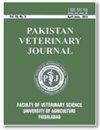Efficacy of Three Different Peste des Petits Ruminants (PPR) Vaccines and Determination of Appropriate Age of PPR Vaccination in Lambs
IF 3.8
3区 农林科学
Q1 VETERINARY SCIENCES
引用次数: 0
Abstract
Received: Revised: Accepted: Published online: January 08, 2019 March 08, 2019 March 20, 2019 April 23, 2019 The study evaluated the efficacy of three different Peste des petits ruminants (PPR) vaccines and assessed the appropriate age of vaccination in lambs born without maternal antibodies at Livestock Experimental Station, Rakh Ghulaman. The lambs (n=94) were divided into ten groups. The lambs in Group A1 (1-<2 month), A2 (2-3 months) and A3 (>3 months) were vaccinated with PPR vaccine from company A and the lambs in Group B1 (1-<2 month), B2 (2-3 months) and B3 (>3 months) were vaccinated with PPR vaccine from company B. However, PPR vaccine from company C was given to four groups of lambs (Group C1, C2, C3 and C4). Serum samples were collected from experimental animals at monthly intervals for five months. Sera were analyzed using c-ELISA. The results indicated that most appropriate age of vaccination against PPR in lambs without maternal antibodies is 2-3 months with any of three vaccines. However, vaccine C may also be used at the age of < 1 month to get protection against PPR. ©2019 PVJ. All rights reserved三种小反刍兽疫疫苗的效果及适宜接种年龄的确定
收到:修订:接受:在线发布:2019年1月8日2019年3月8日3月20日2019年4月23日该研究评估了三种不同的小反刍动物(PPR)疫苗的疗效,并评估了在Rakh Ghulaman牲畜实验站出生的没有母体抗体的羔羊的适当接种年龄。将94只羔羊分为10组。A1组(1-3个月)的羔羊接种了A公司的PPR疫苗,B1组(1-3月)的羊羔接种了B公司的PR疫苗。然而,C公司的PPR疫苗接种给了四组羔羊(C1、C2、C3和C4组)。每隔五个月从实验动物身上采集一次血清样本。使用c-ELISA分析血清。结果表明,对没有母体抗体的羔羊接种PPR疫苗的最合适年龄是2-3个月,接种三种疫苗中的任何一种。然而,疫苗C也可以在<1个月大时使用,以获得预防PPR的保护。©2019 PVJ。保留所有权利
本文章由计算机程序翻译,如有差异,请以英文原文为准。
求助全文
约1分钟内获得全文
求助全文
来源期刊

Pakistan Veterinary Journal
兽医-兽医学
CiteScore
4.20
自引率
13.00%
发文量
0
审稿时长
4-8 weeks
期刊介绍:
The Pakistan Veterinary Journal (Pak Vet J), a quarterly publication, is being published regularly since 1981 by the Faculty of Veterinary Science, University of Agriculture, Faisalabad, Pakistan. It publishes original research manuscripts and review articles on health and diseases of animals including its various aspects like pathology, microbiology, pharmacology, parasitology and its treatment. The “Pak Vet J” (www.pvj.com.pk) is included in Science Citation Index Expended and has got 1.217 impact factor in JCR 2017. Among Veterinary Science Journals of the world (136), “Pak Vet J” has been i) ranked at 75th position and ii) placed Q2 in Quartile in Category. The journal is read, abstracted and indexed internationally.
 求助内容:
求助内容: 应助结果提醒方式:
应助结果提醒方式:


